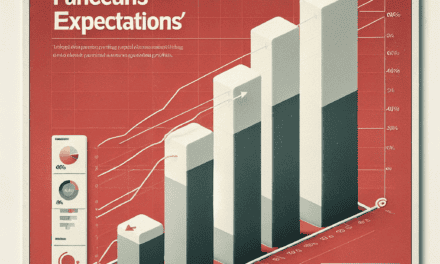“Markets in Limbo: Wall Street Holds Its Breath for Election Outcome”
Introduction
In the lead-up to the U.S. election results, financial markets find themselves in a state of uncertainty, with investors and analysts closely monitoring developments that could significantly impact economic policies and market dynamics. This period of anticipation, often referred to as “Markets in Limbo,” sees Wall Street grappling with volatility and unpredictability as traders weigh potential outcomes and their implications for sectors ranging from healthcare to technology. The election’s outcome is poised to influence fiscal policies, regulatory environments, and international trade relations, making the stakes particularly high for market participants. As a result, trading volumes may fluctuate, and market sentiment can shift rapidly, reflecting the broader economic and political anxieties that accompany such a pivotal event.
Impact Of Political Uncertainty On Stock Market Volatility
As the United States approaches another pivotal election, the financial markets find themselves in a state of limbo, characterized by heightened volatility and uncertainty. Historically, political events have had a profound impact on market behavior, and the current scenario is no exception. Investors, analysts, and policymakers are all keenly aware that the outcome of the election could significantly influence economic policies, regulatory frameworks, and international relations, all of which are critical factors for market stability and growth.
In the weeks leading up to the election, Wall Street has experienced a noticeable increase in volatility. This is largely due to the uncertainty surrounding potential shifts in fiscal policy, taxation, and government spending, which are often contingent on the political party that gains control. Investors are particularly concerned about how these changes might affect corporate earnings, consumer spending, and overall economic growth. Consequently, many are adopting a cautious approach, opting to hold off on major investment decisions until the political landscape becomes clearer.
Moreover, the anticipation of election results has led to a surge in market speculation. Traders are actively trying to predict the outcomes and adjust their portfolios accordingly, which has contributed to erratic market movements. This speculative behavior is further exacerbated by the proliferation of algorithmic trading, where computer programs execute trades based on pre-set criteria, often amplifying market swings. As a result, even minor political developments or opinion polls can trigger significant fluctuations in stock prices.
In addition to domestic concerns, the international community is also closely monitoring the US election. The United States plays a pivotal role in the global economy, and any changes in its trade policies or diplomatic relations can have far-reaching implications. For instance, shifts in tariffs or trade agreements could impact global supply chains, affecting industries ranging from technology to agriculture. Consequently, foreign investors are also exercising caution, contributing to the overall atmosphere of uncertainty.
Despite the current volatility, some market analysts argue that political uncertainty can present opportunities for savvy investors. Historically, periods of heightened volatility have been followed by strong market recoveries, as investors eventually gain clarity and confidence in the new political and economic environment. Therefore, while some may view the current situation as a risk, others see it as a chance to capitalize on potential market mispricings.
Furthermore, it is important to recognize that the stock market is not solely driven by political factors. Economic indicators such as employment rates, inflation, and consumer confidence continue to play a crucial role in shaping market trends. As such, while the election results will undoubtedly have an impact, they are just one of many variables that investors must consider.
In conclusion, as Wall Street awaits the outcome of the US election, the markets remain in a state of flux, characterized by increased volatility and uncertainty. While this environment poses challenges, it also offers potential opportunities for those willing to navigate the complexities of the current landscape. Ultimately, the resolution of political uncertainty will provide much-needed clarity, allowing investors to make more informed decisions and paving the way for future market stability. Until then, the financial world watches with bated breath, acutely aware of the significant implications that the election results may hold.
Historical Analysis: How Past Elections Have Influenced Market Trends
As Wall Street braces for the outcome of the upcoming U.S. elections, investors and analysts alike are keenly aware of the historical patterns that have shaped market trends during past election cycles. Understanding these patterns is crucial for anticipating potential market movements and making informed investment decisions. Historically, U.S. elections have had a profound impact on financial markets, often resulting in heightened volatility and uncertainty. This phenomenon can be attributed to the anticipation of policy changes that accompany a new administration, which can significantly influence economic sectors and investor sentiment.
Looking back, the stock market has exhibited a tendency to react differently depending on whether an incumbent president is re-elected or a new candidate takes office. For instance, when an incumbent wins, markets often experience a sense of continuity and stability, as existing policies are likely to remain in place. This continuity can lead to a more predictable economic environment, which investors generally favor. Conversely, when a new candidate is elected, markets may experience increased volatility due to the uncertainty surrounding potential policy shifts. This uncertainty can lead to cautious investor behavior, as market participants await clarity on the new administration’s economic agenda.
Moreover, the political party of the winning candidate has historically played a role in shaping market trends. Traditionally, markets have responded favorably to Republican victories, driven by expectations of business-friendly policies such as tax cuts and deregulation. On the other hand, Democratic victories have sometimes been met with apprehension, as investors anticipate potential increases in regulation and taxes. However, it is important to note that these reactions are not set in stone and can vary depending on the broader economic context and specific policy proposals put forth by the candidates.
In addition to the immediate aftermath of an election, the long-term impact on markets is also significant. Historical data suggests that the stock market tends to perform well in the year following an election, regardless of which party wins. This post-election rally can be attributed to the resolution of uncertainty and the market’s adjustment to the new political landscape. Furthermore, the economic policies implemented by the new administration can have lasting effects on various sectors, influencing market trends for years to come.
While historical patterns provide valuable insights, it is essential to recognize that each election cycle is unique, shaped by its own set of circumstances and challenges. Factors such as the state of the economy, geopolitical tensions, and technological advancements can all play a role in determining how markets respond to election outcomes. Therefore, while past trends offer a useful framework for understanding potential market reactions, they should not be viewed as definitive predictors of future performance.
As Wall Street awaits the results of the current election, investors are likely to remain cautious, closely monitoring developments and adjusting their strategies accordingly. The lessons gleaned from past elections underscore the importance of staying informed and adaptable in the face of uncertainty. By examining historical trends and considering the unique factors at play in the present election cycle, market participants can better navigate the complexities of the financial landscape and position themselves for success in the post-election environment.
Investor Strategies During Election-Induced Market Fluctuations
As the United States approaches another pivotal election, investors find themselves navigating a landscape marked by uncertainty and volatility. Historically, election periods have been characterized by market fluctuations, as investors grapple with the potential implications of new policies and leadership changes. In this context, it becomes crucial for investors to adopt strategies that can help mitigate risks while capitalizing on potential opportunities. Understanding the dynamics at play during election-induced market fluctuations is essential for making informed investment decisions.
Firstly, it is important to recognize that markets often react to the anticipation of change rather than the change itself. As election day approaches, investors tend to speculate on the possible outcomes and their subsequent impact on various sectors. This speculation can lead to increased volatility, as market participants adjust their portfolios in response to perceived risks and opportunities. Consequently, investors should be prepared for heightened market activity and consider strategies that can help manage this volatility.
One effective approach is diversification, which involves spreading investments across a range of asset classes and sectors. By doing so, investors can reduce their exposure to any single market segment that may be adversely affected by election outcomes. For instance, if a particular candidate is expected to implement policies that could negatively impact the healthcare sector, a diversified portfolio would help cushion the blow by balancing potential losses with gains in other areas. Moreover, diversification can provide a buffer against the unpredictable nature of election results, as it is often difficult to accurately predict which sectors will benefit or suffer under new leadership.
In addition to diversification, maintaining a long-term perspective is crucial during election periods. While short-term market fluctuations can be unsettling, it is important to remember that elections are just one of many factors influencing market performance. Historically, markets have demonstrated resilience, often rebounding after initial election-related volatility. By focusing on long-term investment goals and maintaining a disciplined approach, investors can avoid making impulsive decisions based on short-term market movements.
Furthermore, investors should consider the potential impact of fiscal and monetary policies that may be introduced by the incoming administration. These policies can have significant implications for interest rates, inflation, and overall economic growth. By staying informed about the policy proposals of different candidates, investors can better anticipate potential market shifts and adjust their strategies accordingly. For example, if a candidate is likely to increase infrastructure spending, investors might consider increasing their exposure to sectors such as construction and materials.
Another strategy to consider is the use of hedging techniques to protect against downside risk. Options and futures contracts can be employed to offset potential losses in an investor’s portfolio. While these instruments can be complex and may not be suitable for all investors, they offer a way to manage risk during periods of heightened uncertainty. By carefully evaluating their risk tolerance and investment objectives, investors can determine whether hedging strategies align with their overall investment approach.
In conclusion, as Wall Street awaits the results of the US election, investors must navigate a period of uncertainty and potential market fluctuations. By employing strategies such as diversification, maintaining a long-term perspective, staying informed about policy proposals, and considering hedging techniques, investors can better position themselves to weather the storm. While the outcome of the election remains uncertain, a thoughtful and strategic approach can help investors manage risks and seize opportunities in an ever-changing market landscape.
Sector-Specific Reactions To Election Outcomes

As the United States stands on the cusp of another pivotal election, Wall Street finds itself in a state of uncertainty, with markets exhibiting a cautious stance as they await the results. The anticipation surrounding the election outcomes is palpable, as investors and analysts alike attempt to gauge the potential impacts on various sectors. Historically, elections have been known to influence market dynamics significantly, and this year is no exception. The financial sector, in particular, is poised for a reaction, as regulatory policies and fiscal strategies are likely to shift depending on the election results. A continuation of the current administration might suggest a more deregulatory approach, potentially benefiting banks and financial institutions. Conversely, a change in leadership could herald stricter regulations, which might weigh on the sector’s performance.
Transitioning to the healthcare sector, the stakes are equally high. The election results could determine the future of healthcare policies, including the Affordable Care Act and drug pricing regulations. A government favoring expanded healthcare access and stricter controls on pharmaceutical pricing could impact the profitability of healthcare providers and drug manufacturers. On the other hand, a more conservative approach might prioritize market-driven solutions, potentially benefiting private insurers and pharmaceutical companies. Thus, investors in this sector are closely monitoring the political landscape, as policy shifts could have profound implications for their portfolios.
In the realm of energy, the election outcomes could dictate the trajectory of the industry for years to come. A government that prioritizes renewable energy and environmental regulations could accelerate the transition towards sustainable energy sources, impacting traditional oil and gas companies. This shift could lead to increased investments in solar, wind, and other renewable technologies, reshaping the energy landscape. Conversely, a focus on energy independence and fossil fuel development might bolster traditional energy sectors, providing a boost to oil and gas companies. Consequently, energy investors are keenly aware of the potential for policy-driven changes that could redefine the sector’s future.
The technology sector, often seen as a bellwether for innovation and growth, is also on high alert. Regulatory scrutiny, particularly concerning data privacy and antitrust issues, could intensify depending on the election results. A government inclined towards stricter regulations might pose challenges for tech giants, potentially affecting their market dominance and profitability. Alternatively, a more lenient regulatory environment could foster innovation and expansion, benefiting tech companies and their investors. As such, stakeholders in the technology sector are closely watching the election, understanding that the outcomes could influence the regulatory landscape significantly.
Finally, the consumer goods sector, which is intricately linked to economic policies and consumer confidence, is also poised for potential shifts. Tax policies, trade agreements, and fiscal stimulus measures are all factors that could sway consumer spending and, by extension, the performance of consumer goods companies. A government that prioritizes economic stimulus and consumer spending could bolster this sector, while a focus on fiscal austerity might present challenges.
In conclusion, as Wall Street awaits the US election results, various sectors are bracing for potential shifts in policy and regulation. The financial, healthcare, energy, technology, and consumer goods sectors each face unique challenges and opportunities depending on the election outcomes. Investors are navigating this period of uncertainty with caution, understanding that the results could have far-reaching implications for market dynamics and sector-specific performance. As the nation votes, the markets remain in limbo, poised for a reaction that will undoubtedly shape the economic landscape in the years to come.
The Role Of Economic Policies In Shaping Market Expectations
As the United States approaches another pivotal election, the financial markets find themselves in a state of uncertainty, with investors keenly observing the potential implications of the election outcomes on economic policies. The anticipation surrounding the election results is palpable, as the direction of future economic policies could significantly influence market expectations and investor confidence. Historically, elections have served as critical junctures for financial markets, with policy shifts often leading to fluctuations in market stability and investor sentiment.
Economic policies play a crucial role in shaping market expectations, as they directly impact key factors such as taxation, government spending, and regulatory frameworks. These elements, in turn, affect corporate profitability, consumer spending, and overall economic growth. For instance, a government that prioritizes tax cuts and deregulation may foster a more business-friendly environment, potentially boosting corporate earnings and encouraging investment. Conversely, policies that emphasize increased regulation and higher taxes could lead to concerns about rising operational costs and reduced profit margins, thereby dampening market enthusiasm.
In the context of the upcoming US election, investors are particularly focused on the potential for changes in fiscal and monetary policies. Fiscal policy, which involves government spending and taxation decisions, can have immediate and long-term effects on economic activity. A government that opts for expansionary fiscal policies, such as increased infrastructure spending or direct financial support to households, may stimulate economic growth and enhance market performance. However, such policies could also lead to concerns about rising national debt and inflationary pressures, which might temper investor optimism.
Monetary policy, managed by the Federal Reserve, is another critical area of interest for market participants. The Fed’s decisions on interest rates and quantitative easing measures can influence borrowing costs, liquidity, and overall economic momentum. Investors are keenly aware that a shift towards tighter monetary policy, characterized by higher interest rates, could increase borrowing costs for businesses and consumers, potentially slowing down economic growth. On the other hand, a continuation of accommodative monetary policy might support market valuations by maintaining low interest rates and ample liquidity.
The interplay between fiscal and monetary policies is complex, and the election results could determine the balance between these two forces. Investors are particularly attentive to the potential for policy alignment or divergence between the executive branch and Congress, as this could affect the ease with which new economic measures are implemented. A government with unified control may find it easier to enact its policy agenda, while a divided government might face challenges in passing significant legislative changes, leading to policy gridlock.
In addition to domestic economic policies, global factors also play a role in shaping market expectations. Trade policies, international relations, and geopolitical tensions can all influence investor sentiment and market dynamics. The election outcome could signal shifts in the US’s approach to international trade agreements and diplomatic relations, further adding to the complexity of market forecasting.
As Wall Street awaits the election results, the uncertainty surrounding future economic policies underscores the importance of strategic planning and risk management for investors. While the election outcome will undoubtedly shape the trajectory of economic policies, the inherent unpredictability of political processes serves as a reminder of the need for vigilance and adaptability in navigating the ever-evolving financial landscape. In this period of limbo, market participants remain watchful, ready to adjust their strategies in response to the unfolding political and economic developments.
Global Market Reactions To US Election Results
As the world closely monitors the unfolding events of the United States election, global markets find themselves in a state of uncertainty, reflecting the anticipation and anxiety that accompany such a pivotal moment. Investors and analysts alike are keenly aware that the outcome of the election could significantly influence economic policies, trade agreements, and international relations, all of which have profound implications for global markets. Consequently, financial markets across the globe are exhibiting a cautious stance, with many investors opting to hold their positions until a clearer picture emerges.
In the days leading up to the election, volatility has been a defining characteristic of market behavior. This volatility is not unexpected, as markets often react to the uncertainty surrounding major political events. The potential for shifts in fiscal policy, regulatory changes, and international trade agreements under a new administration can lead to significant market fluctuations. As a result, investors are closely analyzing polling data, campaign promises, and potential policy shifts to gauge the possible impact on various sectors.
Moreover, the interconnected nature of today’s global economy means that the US election results will reverberate far beyond American borders. In Europe, for instance, markets are particularly sensitive to the election’s outcome due to the potential implications for transatlantic trade relations. A change in administration could lead to a reevaluation of tariffs and trade agreements, which would directly affect European exporters and importers. Similarly, Asian markets are also on high alert, as the US plays a crucial role in the region’s economic landscape. The election results could influence US-China relations, impacting trade policies and economic partnerships that are vital to the region’s growth.
In addition to trade, the election outcome could also affect global financial markets through its impact on currency exchange rates. The US dollar, a cornerstone of international trade and finance, often experiences fluctuations in response to political developments. A decisive election result could lead to a strengthening or weakening of the dollar, depending on market perceptions of the incoming administration’s economic policies. This, in turn, would have a ripple effect on other currencies, influencing global trade dynamics and investment flows.
Furthermore, the election’s impact on global markets is not limited to economic factors alone. Geopolitical considerations also play a significant role in shaping investor sentiment. The US’s approach to international alliances, defense policies, and diplomatic relations could undergo significant changes depending on the election outcome. Such shifts could alter the geopolitical landscape, affecting investor confidence and market stability worldwide.
As the world awaits the final results of the US election, it is clear that markets are in a state of limbo, characterized by cautious optimism and underlying apprehension. Investors are acutely aware that the election’s outcome will set the tone for future economic policies and international relations, which will, in turn, shape the trajectory of global markets. In this period of uncertainty, market participants are likely to remain vigilant, closely monitoring developments and adjusting their strategies accordingly. Ultimately, the resolution of the election will provide much-needed clarity, allowing markets to move forward with a renewed sense of direction and purpose. Until then, the global financial landscape remains poised on the edge of anticipation, waiting for the decisive moment that will chart the course for the future.
The Influence Of Media Coverage On Market Sentiment During Elections
As the United States approaches another pivotal election, the financial markets find themselves in a state of uncertainty, a condition that is not unfamiliar during such politically charged periods. The influence of media coverage on market sentiment becomes particularly pronounced during election cycles, as investors and analysts alike attempt to decipher the potential outcomes and their implications for economic policy. This interplay between media narratives and market reactions underscores the complex relationship between information dissemination and investor behavior.
In the lead-up to an election, media outlets are tasked with providing comprehensive coverage of the candidates, their platforms, and the potential impact of their policies on various sectors of the economy. This coverage often includes expert analyses, opinion pieces, and real-time updates, all of which contribute to shaping public perception and, by extension, market sentiment. As investors consume this information, they are influenced not only by the facts presented but also by the tone and framing of the coverage. For instance, a media narrative that emphasizes economic uncertainty under a particular candidate may lead to increased market volatility as investors react to perceived risks.
Moreover, the proliferation of digital media has amplified the speed and reach of election-related information, allowing for rapid dissemination and consumption. Social media platforms, in particular, play a significant role in shaping market sentiment by providing a space for real-time discussions and reactions. These platforms can amplify both positive and negative sentiments, often leading to swift market movements as investors respond to the prevailing mood. The immediacy of information flow in the digital age means that markets are more susceptible to short-term fluctuations based on media coverage, even if the underlying economic fundamentals remain unchanged.
However, it is important to recognize that media coverage is not the sole determinant of market behavior during elections. Investors also rely on a range of other factors, including historical data, economic indicators, and geopolitical considerations, to inform their decisions. Nevertheless, the media’s role in framing the narrative cannot be underestimated, as it often serves as the primary source of information for many market participants. In this context, the media acts as both a mirror and a magnifier of market sentiment, reflecting existing concerns while also potentially exacerbating them through repeated coverage.
As election day approaches, the anticipation of potential policy shifts can lead to heightened market sensitivity. Investors may adopt a cautious stance, opting to wait for clearer signals before making significant moves. This period of limbo is characterized by increased volatility, as markets react to the ebb and flow of media narratives and the latest polling data. The uncertainty surrounding the election outcome can lead to a risk-off sentiment, with investors seeking safe-haven assets until a clearer picture emerges.
In conclusion, the influence of media coverage on market sentiment during elections is a multifaceted phenomenon that reflects the dynamic interplay between information, perception, and investor behavior. While media narratives are not the sole drivers of market movements, they play a crucial role in shaping the context within which investors operate. As Wall Street awaits the results of the US election, the markets remain in a state of limbo, poised to react to the unfolding political landscape and the media’s portrayal of its potential impact on the economy.
Q&A
1. **What is the current state of the markets?**
Markets are experiencing volatility and uncertainty as investors await the outcome of the US election.
2. **How are investors reacting to the election uncertainty?**
Investors are cautious, leading to fluctuating stock prices and increased demand for safe-haven assets.
3. **Which sectors are most affected by the election uncertainty?**
Financials, healthcare, and technology sectors are among those most impacted due to potential policy changes.
4. **What are safe-haven assets, and why are they in demand?**
Safe-haven assets like gold and government bonds are in demand as they are perceived as more stable during uncertain times.
5. **How might the election results impact fiscal policy?**
The election results could significantly influence fiscal policy, including tax rates and government spending.
6. **What are analysts predicting for the market post-election?**
Analysts predict that markets may stabilize once election results are clear, but the direction will depend on the policy implications of the outcome.
7. **How are global markets responding to the US election uncertainty?**
Global markets are also experiencing volatility, as the US election has significant implications for international trade and economic policies.
Conclusion
The uncertainty surrounding the US election results has left financial markets in a state of limbo, characterized by heightened volatility and cautious investor sentiment. As Wall Street awaits clarity, market participants are grappling with potential policy shifts that could impact sectors differently depending on the election outcome. This period of ambiguity has led to fluctuating stock prices, with investors hedging their bets and seeking safe-haven assets. The resolution of the election is expected to provide direction, potentially stabilizing markets and allowing for more informed investment decisions based on the anticipated economic and regulatory landscape.





